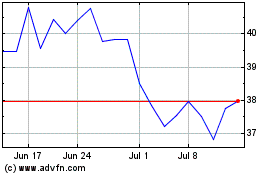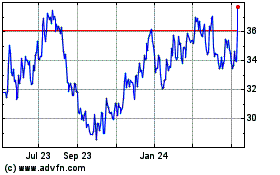Commodities Costs Have Restaurants Cutting Closer To The Bone
May 05 2011 - 10:10AM
Dow Jones News
After trimming the obvious fat, restaurant chains are now having
to cut closer to the bone as they look for ways to combat rising
food costs and preserve healthy margins while avoiding significant
price hikes.
"There's only so much low-hanging fruit. After that, you've
really got to strive to get the rest of it, so this year is going
to be a little tougher," said Alice LeBlanc, chief global supply
chain officer for AFC Enterprises Inc.'s (AFCE) Popeye's Louisiana
Kitchen.
Most restaurant chains are expecting their commodities costs to
rise as much as 4% this year, but can only afford to push prices up
enough to offset half of that without losing market share.
The fried chicken chain was able to trim about $16 million off
its costs in 2010, bringing franchisees one percentage point of
improvement in restaurant operating profit margins before rent
compared with the prior year.
Popeye's made its distribution more efficient by ensuring every
truckload was full and by negotiating longer-term contracts with
suppliers that are more beneficial to both parties. The fast food
chain also created a purchasing co-op to leverage its volume and
pay lower prices.
"No one would've anticipated what we've truly experienced this
year in commodities inflation, so it was incredible that we did
start with the cost cutting when we did," LeBlanc said.
Now, Popeye's is on to the little things.
"When we were making a lot of money, we didn't really think
about the little things, because who wants to think about cleaning
solution or bathroom products," LeBlanc said. "But now, every
little thing counts. It all adds up."
Darden Restaurants Inc. (DRI) Chief Operating Officer Andrew
Madsen says the operator of Olive Garden, Red Lobster and Longhorn
Steakhouse chains has four cost-saving projects underway to help
offset the elevated cost pressures.
The company is automating its supply chain; centralizing
restaurant facilities repair and maintenance programs; adopting
more sustainable restaurant operating practices for energy, water
and cleaning supplies usage; and implementing an in-restaurant
labor optimization program. Darden estimates these changes can save
it $110 million to $130 million.
"We want to use those savings to help protect our price point
accessibility and breadth of appeal of our brands, and not suffer
any margin dilution at all," Madsen said on a conference call.
DineEquity Inc. (DIN) Chief Executive Julia Stewart says
DineEquity continues working with franchisees at its Applebee's and
IHOP restaurant chains to find cost reductions that will help them
through these tough times.
Lately, at IHOP, it has implemented new tools that help with
food portioning to reduce waste, which in turn lowers food
costs.
"It's an ongoing effort, every month we look at options to cut
where we can," Stewart said. "Yes, we did already get the obvious
things, but as a restaurant operator, you'll never get me to say
there isn't another way to cut costs. You can always find a
way."
Cheesecake Factory Inc. (CAKE) says it's implementing $3 million
to $5 million in cost savings initiatives in the second half of the
year, as well as ongoing improvements in labor productivity.
Texas Roadhouse Inc. (TXRH) suffered a decline in its
restaurant-level margins, despite its same-store sales rising in
the first quarter with guest traffic up 4.2%, because the
restaurant refrained from raising menu prices to levels that would
fully offset its 3% commodities cost inflation.
To stick with its low prices, Texas Roadhouse Chief Financial
Officer Scott Colosi says the steakhouse has contracted out
expenses such as electric, gas, waste management and phones,
continually negotiating those contracts downward.
"We're always looking at our purchasing power to see what we can
do," Colosi said on a conference call. "And we continue to
challenge folks on the labor end, particularly, how early people
come in to start their shifts and when they leave, and we try to
match that up with the business."
Brinker International Inc. (EAT) Chief Financial Officer Guy
Constant says its Chili's bar and grill chain's "kitchen retrofit"
program, being rolled out now, optimizes the labor component of the
food preparation process, among other efficiencies. He expects it
to result in a noticeable reduction in labor and cost of sales
through reduced waste. It could also bring utility savings because
the new equipment is much more energy efficient, he added.
-By Annie Gasparro, Dow Jones Newswires; 212-416-2244;
annie.gasparro@dowjones.com
Cheesecake Factory (NASDAQ:CAKE)
Historical Stock Chart
From Mar 2024 to Apr 2024

Cheesecake Factory (NASDAQ:CAKE)
Historical Stock Chart
From Apr 2023 to Apr 2024
